Managing Innovative Education in Public Secondary Schools for Sustainable Development in Rivers State
Main Article Content
Abstract
The study examined managing innovative education in public secondary schools for sustainable development in Rivers State. Three objectives with corresponding research questions and hypotheses guided the study. The design of the study was descriptive survey with the population of 6,153 principals and teachers in 320 public senior secondary schools in Rivers State, from which 615 representing (10%) of the population were selected as sample, using the proportionate stratified sample sampling technique. Respondents responded to a validated 18 item instrument of which was a questionnaire, titled: Managing Innovative Education in Public Secondary Schools for Sustainable Development Questionnaire (MIEPSSSDQ) designed by the researcher after the modified 4-points Likert scale model, with a reliability index of 0.89, obtained using Cronbach alpha statistics. Mean and standard deviation were used in answering the research questions, while z-test was used in testing the hypotheses at 0.05 level of significance. The findings of the study revealed that sustainable development cannot be achieved except administrators play their role by ensuring that essential ingredients required for managing innovative education in public secondary schools properly implemented, even though there may be some factors hindering the managing of innovative education for sustainable development. Consequently, it was recommended among others that administrators in schools should work with outstretched arms with their subordinates to ensure that they play their roles very well to achieve proper management of innovative education for sustainable development. This is because collaboration and effective communication are important for innovations to take place in schools. Also, school administrators should be carefully selected and trained to ensure that the essential ingredients required for managing innovative education in public secondary schools are effectively implemented for attainment of sustainable development.

